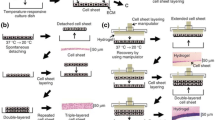Abstract
Motivated by recent success in growing biohybrid material from engineered tissues on synthetic polymer films, we derive a computational simulation tool for muscular thin films in cardiac repair. In this model, the polydimethylsiloxane base layer is simulated in terms of microscopically motivated tetrahedral elements. Their behavior is characterized through a volumetric contribution and a chain contribution that explicitly accounts for the polymeric microstructure of networks of long chain molecules. Neonatal rat ventricular cardiomyocytes cultured on these polymeric films are modeled with actively contracting truss elements located on top of the sheet. The force stretch response of these trusses is motivated by the cardiomyocyte force generated during active contraction as suggested by the filament sliding theory. In contrast to existing phenomenological models, all material parameters of this novel model have a clear biophyisical interpretation. The predictive features of the model will be demonstrated through the simulation of muscular thin films. First, the set of parameters will be fitted for one particular experiment documented in the literature. This parameter set is then used to validate the model for various different experiments. Last, we give an outlook of how the proposed simulation tool could be used to virtually predict the response of multi-layered muscular thin films. These three-dimensional constructs show a tremendous regenerative potential in repair of damaged cardiac tissue. The ability to understand, tune and optimize their structural response is thus of great interest in cardiovascular tissue engineering.
Similar content being viewed by others
References
Abilez O, Benharash P, Mehrotra M, Miyamoto E, Gale A, Picquet J, Xu C, Zarins C (2006) A novel culture system shows that stem cells can be grown in 3D and under physiologic pulsatile conditions for tissue engineering of vascular grafts. J Surg Res 132: 170–178
Abilez O, Benharash P, Miyamoto E, Gale A, Xu C, Zarins CK (2006) P19 progenitor cells progress to organized contracting myocytes after chemical and electrical stimulation: Implications for vascular tissue engineering. J Endovasc Ther 13: 377–388
Allen DG, Jewell BR, Murray JW (1974) The contribution of activation processes to the length-tension relation of cardiac muscle. Nature 248: 606–607
Bers DM (2001) Excitation-contraction coupling and cardiac contractile force. Springer, Berlin
Bers DM (2002) Cardiac excitation contraction coupling. Nature 415: 198–205
Blemker SS, Delp SL (2005) Three-Dimensional Representation of Complex Muscle Architectures and Geometries. Ann Biomed Eng 33: 661–673
Böl M, Reese S (2005) New method for simulation of Mullins effect using finite element method. Plast Rub Comp 34: 343–348
Böl M, Reese S (2005) Finite element modelling of rubber-like materials—a comparison between simulation and experiment. J Mat Sci 40: 5933–5939
Böl M, Reese S (2006) Finite element modelling of rubber-like polymers based on chain statistics. Int J Sol Struc 43: 2–26
Böl M, Reese S (2007) A new approach for the simulation of skeletal muscles using the tool of statistical mechanics. Mat Sci Eng Tech 38: 955–964
Böl M, Reese S (2008) Micromechanical modelling of skeletal muscles based on the finite element method. Comp Meth Biomech Biomed Eng (in press)
Cao F, Sadrzadeh A, Abilez O, Wang H, Pruitt B, Zarins C, Wu J (2007) In vivo imaging and evaluation of different biomatrices for improvement of stem cell survival. J Tissue Eng Regen Med 1: 465–468
Feinberg AW, Feigel A, Shevkoplyas SS, Sheehy S, Whitesides GM, Parker KK (2007) Muscular thin films for building actuators and powering devices. Science 317: 1366–1370
Feinberg AW, Feigel A, Shevkoplyas SS, Sheehy S, Whitesides GM, Parker KK (2007) Supporting Online Material for: Muscular thin films for building actuators and powering devices. Science 317: 1–17
Flory PJ (1969) Statistical Mechanics of Chain Molecules. Wiley, Chichester
Gordon AM, Huxley AF, Julian FJ (1966) The variation in isometric tension with sarcomere length in vertebrate muscle fibres. J Phys 184: 170–192
Hunter PJ, McCulloch AD, ter Keurs JEDJ (1998) Modelling the mechanical properties of cardiac muscle. Prog Biophys Mol Biol 69: 289–331
Huxley H, Hanson J (1954) Changes in the cross-striations of muscle during contraction and stretch and their structural interpretation. Nature 173: 973–976
Kuhn W (1934) Über die Gestalt fadenförmiger Moleküle in Lösungen. Kolloid Z 68: 2–15
Kuhn W (1936) Beziehungen zwischen Molekühlgrösse, statistischer Molekülgestalt und elastischen Eigenschaften hochpolymerer Stoffe. Kolloid Z 76: 258–271
Kumar V, Abbas AK, Fausto N (2005) Robbins and Cotran pathologic basis of disease. Elsevier, Saunders, Amsterdam, Philadelphia
Kurpinkski K, Chu J, Hashi C, Li S (2007) Anisotropic mechanosensing by mesenchymal stem cells. PNAS 103: 16095–16100
Luo CH, Rudy Y (1991) A dynamic model of the cardiac ventricular action potential: I. Simulations of ionic currents and concentration changes. Circ Res 74: 1071–1096
Opie LH (2003) Heart Physiology: From Cell to Circulation. Lippincott Williams & Wilkins, Philadelphia
Treloar LRG (1975) The Physics of Rubber Elasticity. Clarendon Press, Oxford
Wollert KC, Meyer GP, Lotz J, Ringes-Lichtenberg S, Lippolt P, Breidenbach C, Fichtner S, Korte T, Hornig B, Messinger D, Arseniev L, Hertenstein B, Ganser A, DrexlerH Wollert KC, Meyer GP, Lotz J (2004) Intracoronary autologous bone-marrow cell transfer after myocardial infarction: the BOOST randomised controlled clinical trial. Lancet 364: 141–148
Zimmermann WH, Melnychenko I, Wasmeier G, Didié M, Naito J, Nixdorff U, Hess A, Budinsky L, Brune K, Michaelis B, Dhein S, Schwoerer A, Ehmke H, Eschenhagen T (2006) Engineered heart tissue grafts improve systolic and diastolic function in infarcted rat hearts. Nat Med 124: 452–458
Author information
Authors and Affiliations
Corresponding author
Rights and permissions
About this article
Cite this article
Böl, M., Reese, S., Parker, K.K. et al. Computational modeling of muscular thin films for cardiac repair. Comput Mech 43, 535–544 (2009). https://doi.org/10.1007/s00466-008-0328-5
Received:
Accepted:
Published:
Issue Date:
DOI: https://doi.org/10.1007/s00466-008-0328-5




